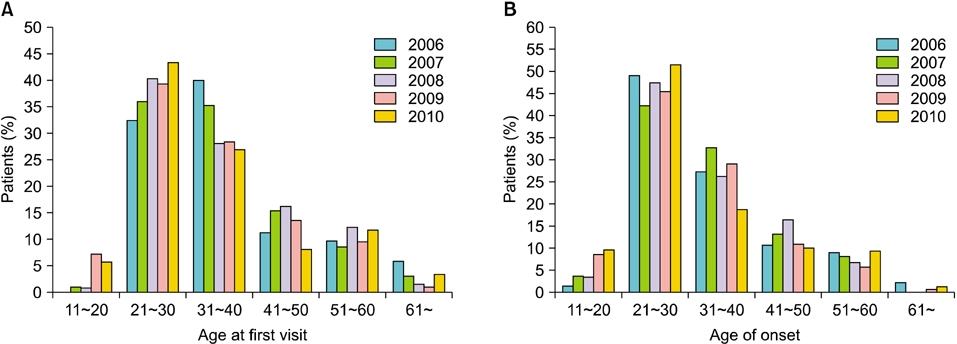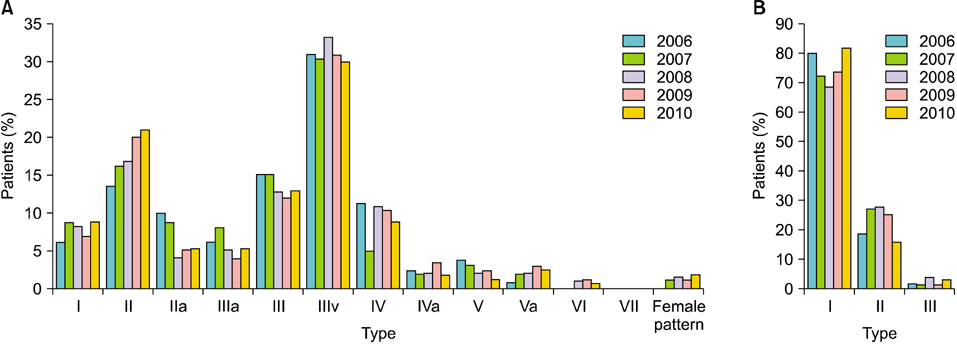Ann Dermatol.
2013 May;25(2):181-188. 10.5021/ad.2013.25.2.181.
The Annual Changes of Clinical Manifestation of Androgenetic Alopecia Clinic in Korean Males and Females: A Outpatient-Based Study
- Affiliations
-
- 1Department of Dermatology, College of Medicine, Chung-Ang University, Seoul, Korea. Hongck@cau.ac.kr
- KMID: 2171786
- DOI: http://doi.org/10.5021/ad.2013.25.2.181
Abstract
- BACKGROUND
Androgenetic alopecia (AGA) is characterized by the local and gradual transformation of terminal scalp hair into vellus hair, which has a shorter and thinner shaft. There are no studies that analyze annual changes in age, patterns, family history, and associated disease.
OBJECTIVE
We investigated the severity of hair loss, age of onset, the frequency of family history, and past medical histories in Korean patients with AGA.
METHODS
A retrospective chart review was performed to identify all patients with AGA referred to the Dermatology Clinic at Chung-Ang University Hospital from January 2006 to December 2010.
RESULTS
The age of onset was also gradually decreased from 34.1+/-10.1 years to 31.6+/-10.9 years between 2006 and 2010. In female patients, specific annual changes were not observed. Hamilton-Norwood Type IIIv AGA was most common in male patients and Ludwig Type I AGA was most common in female patients at all times between 2006 and 2010. The majority of patients with AGA had a family history of baldness and was most commonly associated with a paternal pattern of inheritance. Seborrheic dermatitis was the most common associated disease in male and female patients.
CONCLUSION
Our results show the possibilities that the average age of onset is decreasing. The period of the present study was only 5 years, which is not sufficient for the precise determination of onset age for AGA. Clearly, a long-term study is needed.
Keyword
MeSH Terms
Figure
Cited by 1 articles
-
Safety and Tolerability of the Dual 5-Alpha Reductase Inhibitor Dutasteride in the Treatment of Androgenetic Alopecia
Gwang Seong Choi, Joon Hyung Kim, Shin-Young Oh, Jung-Min Park, Ji-Soo Hong, Yil-Seob Lee, Won-Soo Lee
Ann Dermatol. 2016;28(4):444-450. doi: 10.5021/ad.2016.28.4.444.
Reference
-
1. Birch MP, Messenger JF, Messenger AG. Hair density, hair diameter and the prevalence of female pattern hair loss. Br J Dermatol. 2001. 144:297–304.
Article2. Paik JH, Yoon JB, Sim WY, Kim BS, Kim NI. The prevalence and types of androgenetic alopecia in Korean men and women. Br J Dermatol. 2001. 145:95–99.
Article3. Tang L, Bernardo O, Bolduc C, Lui H, Madani S, Shapiro J. The expression of insulin-like growth factor 1 in follicular dermal papillae correlates with therapeutic efficacy of finasteride in androgenetic alopecia. J Am Acad Dermatol. 2003. 49:229–233.
Article4. Imperato-McGinley J, Gautier T. Inherited 5-α-reductase deficiency in men. Trends Genet. 1986. 2:130–133.5. Kaufman KD. Androgen metabolism as it affects hair growth in androgenetic alopecia. Dermatol Clin. 1996. 14:697–711.
Article6. Drake L, Hordinsky M, Fiedler V, Swinehart J, Unger WP, Cotterill PC, et al. The effects of finasteride on scalp skin and serum androgen levels in men with androgenetic alopecia. J Am Acad Dermatol. 1999. 41:550–554.
Article7. Xu F, Sheng YY, Mu ZL, Lou W, Zhou J, Ren YT, et al. Prevalence and types of androgenetic alopecia in Shanghai, China: a community-based study. Br J Dermatol. 2009. 160:629–632.
Article8. Hamilton JB. Patterned loss of hair in man; types and incidence. Ann N Y Acad Sci. 1951. 53:708–728.
Article9. Norwood OT, Lehr B. Female androgenetic alopecia: a separate entity. Dermatol Surg. 2000. 26:679–682.
Article10. Trüeb RM. Female pattern baldness in men. J Am Acad Dermatol. 1993. 29:782–783.
Article11. Venning VA, Dawber RP. Patterned androgenic alopecia in women. J Am Acad Dermatol. 1988. 18:1073–1077.
Article12. Wang TL, Zhou C, Shen YW, Wang XY, Ding XL, Tian S, et al. Prevalence of androgenetic alopecia in China: a community-based study in six cities. Br J Dermatol. 2010. 162:843–847.
Article13. Rhodes T, Girman CJ, Savin RC, Kaufman KD, Guo S, Lilly FR, et al. Prevalence of male pattern hair loss in 18-49 year old men. Dermatol Surg. 1998. 24:1330–1332.
Article14. Severi G, Sinclair R, Hopper JL, English DR, McCredie MR, Boyle P, et al. Androgenetic alopecia in men aged 40-69 years: prevalence and risk factors. Br J Dermatol. 2003. 149:1207–1213.
Article15. DeMuro-Mercon C, Rhodes T, Girman CJ, Vatten L. Male-pattern hair loss in Norwegian men: a community-based study. Dermatology. 2000. 200:219–222.
Article16. Gan DC, Sinclair RD. Prevalence of male and female pattern hair loss in Maryborough. J Investig Dermatol Symp Proc. 2005. 10:184–189.
Article17. Khumalo NP, Jessop S, Gumedze F, Ehrlich R. Hairdressing and the prevalence of scalp disease in African adults. Br J Dermatol. 2007. 157:981–988.
Article18. Han ES, Kim MN, Hong CK, Ro BI. A clinical study of androgenetic alopecia. Korean J Dermatol. 1995. 33:44–52.19. Ro BI, Ro SW, Shim JH. A clinical study of androgenetic alopecia (III). Ann Dermatol. 2002. 14:11–17.
Article20. Kim JE, Ahn JY, Ro BI. A clinical study of androgenetic alopecia (V). Korean J Dermatol. 2005. 43:319–324.21. Hadshiew IM, Foitzik K, Arck PC, Paus R. Burden of hair loss: stress and the underestimated psychosocial impact of telogen effluvium and androgenetic alopecia. J Invest Dermatol. 2004. 123:455–457.
Article22. González-González JG, Mancillas-Adame LG, Fernández-Reyes M, Gómez-Flores M, Lavalle-González FJ, Ocampo-Candiani J, et al. Androgenetic alopecia and insulin resistance in young men. Clin Endocrinol (Oxf). 2009. 71:494–499.
Article23. Gimeno SG, Andreoni S, Ferreira SR, Franco LJ, Cardoso MA. Assessing food dietary intakes in Japanese-Brazilians using factor analysis. Cad Saude Publica. 2010. 26:2157–2167.
Article24. Norwood OT. Male pattern baldness: classification and incidence. South Med J. 1975. 68:1359–1365.
Article25. Ludwig E. Classification of the types of androgenetic alopecia (common baldness) occurring in the female sex. Br J Dermatol. 1977. 97:247–254.
Article26. Lee WS, Ro BI, Hong SP, Bak H, Sim WY, Kim do W, et al. A new classification of pattern hair loss that is universal for men and women: basic and specific (BASP) classification. J Am Acad Dermatol. 2007. 57:37–46.
Article27. Osborn D. Inheritance of baldness. J Hered. 1916. 7:347–355.
Article28. Chumlea WC, Rhodes T, Girman CJ, Johnson-Levonas A, Lilly FR, Wu R, et al. Family history and risk of hair loss. Dermatology. 2004. 209:33–39.
Article29. Ellis JA, Sinclair R, Harrap SB. Androgenetic alopecia: pathogenesis and potential for therapy. Expert Rev Mol Med. 2002. 4:1–11.
Article30. Gupta AK, Bluhm R, Cooper EA, Summerbell RC, Batra R. Seborrheic dermatitis. Dermatol Clin. 2003. 21:401–412.
Article31. Kim BJ, Kim JY, Eun HC, Kwon OS, Kim MN, Ro BI. Androgenetic alopecia in adolescents: a report of 43 cases. J Dermatol. 2006. 33:696–699.
Article32. Yoo KH, Rho YK, Kim DH, Park J, Kim BJ, Kim MN, et al. A clinical study of androgenic alopecia (VII). Korean J Dermatol. 2009. 47:765–771.33. Ahouansou S, Le Toumelin P, Crickx B, Descamps V. Association of androgenetic alopecia and hypertension. Eur J Dermatol. 2007. 17:220–222.34. Matilainen V, Koskela P, Keinänen-Kiukaanniemi S. Early androgenetic alopecia as a marker of insulin resistance. Lancet. 2000. 356:1165–1166.
Article



